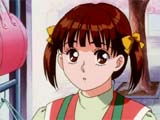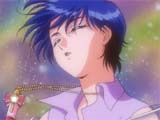

Quick Links:
Fancy Lala, Volume 1: A Star is Born!
Fancy Lala is an addition to the genre of mahou shoujo (magical girl) shows, a popular subset of anime which includes series like Sailor Moon. In almost all of these shows, the main characters undergo the patented magical girl transformation, which involves nakedness in most cases. Fancy Lala is slightly different from most, because the main character actually transforms into an older girl. Though the story is formulaic in presentation, it turns out that Fancy Lala has a lot to offer.
The series centers around 9 year-old Miho, a normal girl by any stretch. The story opens with a dream of hers, in which a strange man appears and her town is set ablaze by a couple of creatures that look like Godzilla. Back in reality, Miho gets into a bit of trouble while shopping. As she's leaving a store, the clerk stops her because she has two strange-looking plush toys stuck to her bag, and she can't take them off! Suddenly, the strange man from before appears, and insists that she keep the toys. He pays the clerk to appease him, and disappears. As anyone could guess, Miho's life is about to change.
Miho finds out when she gets home that the toys (named Pigu and Mogu) can talk! They offer her magic in return for food. The magic they have comes in the form of a pen, with a clock in it, and a sketchbook. The pen can be used to draw clothing (on the sketchbook), and transform the drawing into real clothes. The other use is (as one could probably guess) to alter time, and transforms Miho into 15 year-old Fancy Lala.
The story constructs in Fancy Lala are simple, almost cliché even, but there are some interesting parallels going on. For instance, Miho is an energetic and friendly girl, but she is also extremely shy. This is demonstrated by her inability to speak coherently when introducing herself on the first day of school. She aspires to be a comic artist, and does a lot of drawing. Because of her aptitude for drawing, she is able to come up with very intelligent designs for Lala's clothing. During one of the times she becomes Lala, she is discovered by a modeling agency in desparate need for someone to do a photo shoot. Lala seems to adapt well to all the attention, whereas Miho would have been sick with stage fright. In this example, an interesting point is raised. The fact that Miho is more confident in herself when transformed into Lala is indicative of the fact that there's no responsibility attached. The pressure begins to build, however, when Lala becomes more popular.
Another interesting parallel is how Miho/Lala relates to her family. Miho's father studies dinosaurs, mostly at home, and as thus leads a rather quiet and reserved life. His wife is a polar opposite, having a very important position at a TV studio and dealing with many people each day. Miho's sister, Chisa, is almost like a clone of their mother. Miho, however, seems to have more in common with her father, except when she's transformed as Lala. Lala on the whole is more similar to Chisa, but some of the reserved traits are still present, since Lala is of course just Miho in a different suit. Though fundamentally simple, Fancy Lala's story is anything but boring. The first volume suggests a promising future for the rest of the show.
Fancy Lala's music in the first volume is nothing special, but it's cute and fits the carefree mood of the story pretty well. The opening song is almost too cute though, and can be difficult to put up with when viewing multiple episodes (thank goodness for the track skip button on the remote). The ending theme is more easily digested. It's still very cute, but doesn't go overboard with it. The voice acting in the show is also not anything special in the first volume (with Reiko Omori's Lala voice being an exception). It does the job, but doesn't exactly stand out. Overall, the audio aspects of the show aren't outstanding but do what they're supposed to.
The female characters in this show are just plain cute, and the male characters are ordinary to bland, as is common for many anime shows. The animation for the show uses recycled footage a lot for scenes such as Miho's transformation, but the animators behaved themselves for most of the footage. The video quality for this first volume isn't noticably exceptional, but carries a high quality like most of the recent Bandai transfers.
Extras on the disc aren't numerous. There's only a textless version of the opening song, and trailers for three other Bandai shows. The best way to describe the packaging for the first volume is: pink, VERY pink. It has a picture of Miho and Lala on the front, and a few screens on the back. The insert contains credits for the show and episode synopses, and so is pretty informative.
In summary, this is a series worth checking out. I'm not wild about magical girl shows, but this one actually has my interest. This show is suitable for all ages, and the great cast gives it a fresh feel.
Distributor: Bandai Entertainment Creator: Studio Pierrot Released: 1998
Video Quality: A Audio Quality: A Presentation: B Content: A- Overall: A-



